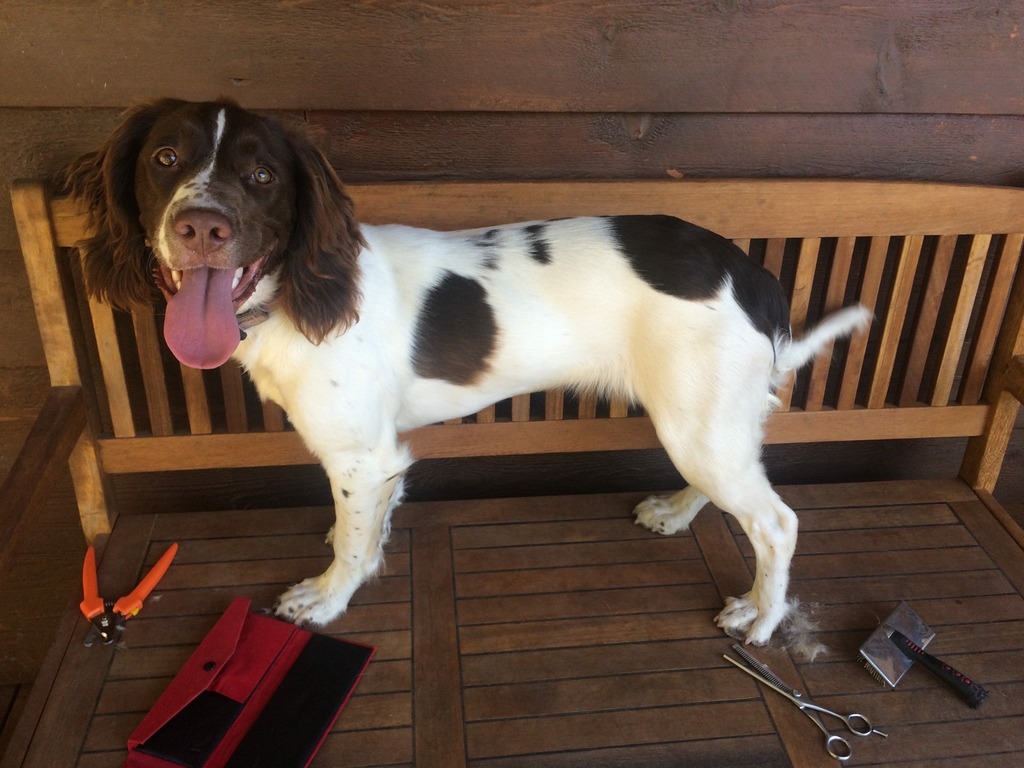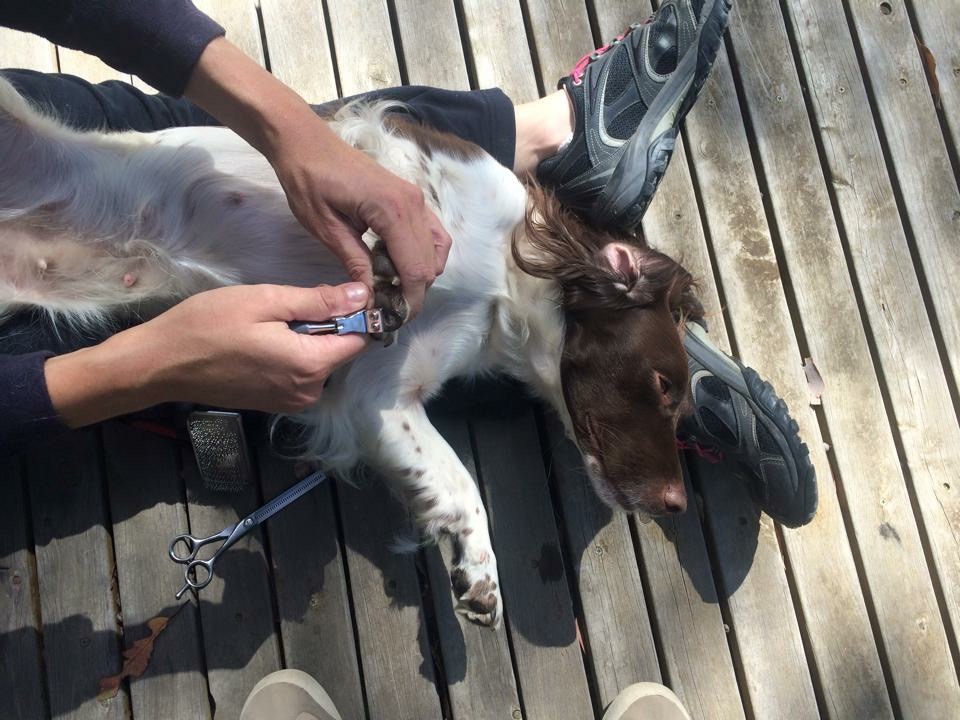Exercise and Grooming
EXERCISE
Field-bred English Springer Spaniels just love to run and it can be tempting to give them as much exercise as they can take.
However, inappropriate or over-exercising in the first 12-18 months can put a lot of pressure on the long-bone growth plates and can have permanent detrimental effects on the musculoskeletal system and lead to arthritis in later life.
Inappropriate exercise includes activities such as:
- Repetitive ball chasing (this is quite different to retrieving training due to the skidding action of the dog as the ball rolls along the ground)
- Playing or running on slippery surfaces (for example, tiles and floor boards)
- Constant rough play with other dogs
- Running up and down stairs
- Extended walks, jogging or running next to a bike
At Thornfield we do our utmost to select dogs for our breeding progam that are healthy and sound but the genes that cause hip dysplasia remain a mystery. The environmental effects of inappropriate diet, exercise and obesity are well recognised as signficant contributers to joint issues such as hip dysplasia. In their first 8 weeks with us puppies are exposed to a variety of indoor surfaces that allow them to grip firmly, rather than slip and slide, for example, marine carpet, interlocking foam tiles, slate floor and heavy rugs. We always ensure our youngsters and adults train on a stable and cushioned surface, even when we train on our deck:
Puppy buyers must accept a level of responsibility for raising healthy, happy, well socialised puppies. Walks for young dogs and puppies should be about socialisation and training above all else whilst free running, playing with well matched dogs and swimming are all great ways to expend some of that Spaniel energy. Read more about appropriate exercise here.
Remember to work the mind as much as you work the body.
Variety and moderation is the key!
GROOMING
Brushing
Field-bred ESS do not require a lot of grooming – generally a quick brush all over using a soft slicker brush, especially of the longer hair around the ears, on a weekly basis is sufficient. They have much less coat than show-bred ESS but texture, length and density of coat will vary with the individual, their age and whether or not they are desexed.
We do groom our dogs more regularly simply because we enjoy it - both the humans and the dogs! It's a means of bonding, relaxing and a good opportunity to feel our dogs all over for any unusual lumps or bumps. We also find that Em's ears need more regular grooming since Ginny started using them as tug toys!
Bathing and Trimming
We rarely bath our Springers because they always seem to be swimming and the dirt generally drops out of the coat very easily. We tend to keep the hair trimmed (using single sided scissors) between the toes, around the hind leg hock, up to the first joint of the front leg and to the tail tip to reduce muddy paws and the risk of grass seeds. The less said about my skills as a groomer the better but I do find the single sided scissors are very forgiving. And the hair does grow back! Sometimes I trim them whilst they are standing up and other times whilst they're upside down on my lap. With the young dogs, I try to do it when they've had a good run and training session so they can relax instead of quivering with energy. Here's young Ginnny having her first trim...
Grass Seeds
It's important to keep an eye on your dog’s paws and ears, in particular, for grass seeds, which can be rife in Summer. The first sign is often sudden licking of the paw or scratching the ears or bad smelling ears. If we can’t easily extract the grass seed from the paw but can clearly see it we will apply a drawing ointment and a child's sock but do talk to your vet as they are not to be trifled with. This video shows just how quickly a grass seed can migrate through a swab - of course it will move more slowly through skin but it's a great illustration.
I've even extracted one from Em's nostril after I noticed her sneezing in the middle of a dinner party - it certainly made for interesting conversation! This video shows a tiny grass seed being extracted from a young Springer Spaniel's tear duct:
It sounds a bit odd but when you are grooming or relaxing with your Springer, get in the habit of having a sniff inside their ears - initially you will learn what a healthy inner ear smells like and later you will get an early warning sign if there is something amiss. A few years ago I took one of our Springers to my vet for her hip and elbow x-rays and scoring. When I dropped her off I asked the staff to have a quick look in her right ear whilst she was anaesthetised as "it just didn't smell quite right". She wasn't shaking her head or scratching her ear at all so both the vet and I were stunned when he found a huge black grass seed on the verge of perforating her ear drum! This would have likely gone unnoticed and developed into a much more painful (and expensive!) problem to solve. As it was, he carefully extracted the grass seed and she was on ear drops for a few weeks.
Some dogs can be incredibly stoic and it takes careful observation to realise something is not quite right. After realising both Em and Ginny were a little flat and hesitant to shake their head, an examination using an otoscope revealed that they seemed to have a couple of grass seeds deep within their inner ear. A veterinary examination confirmed this so both girls were given a general anaesthetic and, much to our vets' amazement, 40 grass seeds were removed between them. They must have been incredibly uncomfortable but just didn't show it.
Ears
Our ESS very rarely have any problems with their ears after swimming. The ear leather is very light and the ear canals tend to be quite open so, provided they get to run around afterwards, the ear tends to dry out reasonably quickly. On those rare occasions when the dog repeatedly scratches their ear or shakes their head we will use a little Epi-otic but a dog that shows no sign of improvement within 24 hours will be off to the vet as there's always the risk of a grass seed. We certainly do not recommend prophylactic cleaning and ear plucking should be completely unneccessary.
Nails
Check out this great article: Cutting Your Dog's Nails...How Important Is It Really?
Thornfield puppies start their nail trimming experience at only 3 days old and thereafter weekly as a minimum. Our puppies are used to being quietly cuddled on our lap when relaxed - possibly with a yummy chew toy to keep them busy - and the very tip of the nail is trimmed using human nail clippers.
As they get older and the nail gets thicker they need larger nail clippers designed for dogs or a dremmel.
Our pups are very relaxed about having their paws and nails handled and it's important that this continues to be a pleasureable experience for them. Some of our puppy buyers can't believe how nonplussed their pups are about having their nails trimmed with some even falling asleep! Even our cats love having their nails done...
They often get a relaxing brush in between having each paw done and a special treat once we are done. We trim our adult dogs' nails at least fortnightly - little and often is the best approach. And don't forget the dewclaws on the front feet! It's not difficult but it can take some practice if you are not used to it.
© Thornfield English Springer Spaniels 2024




